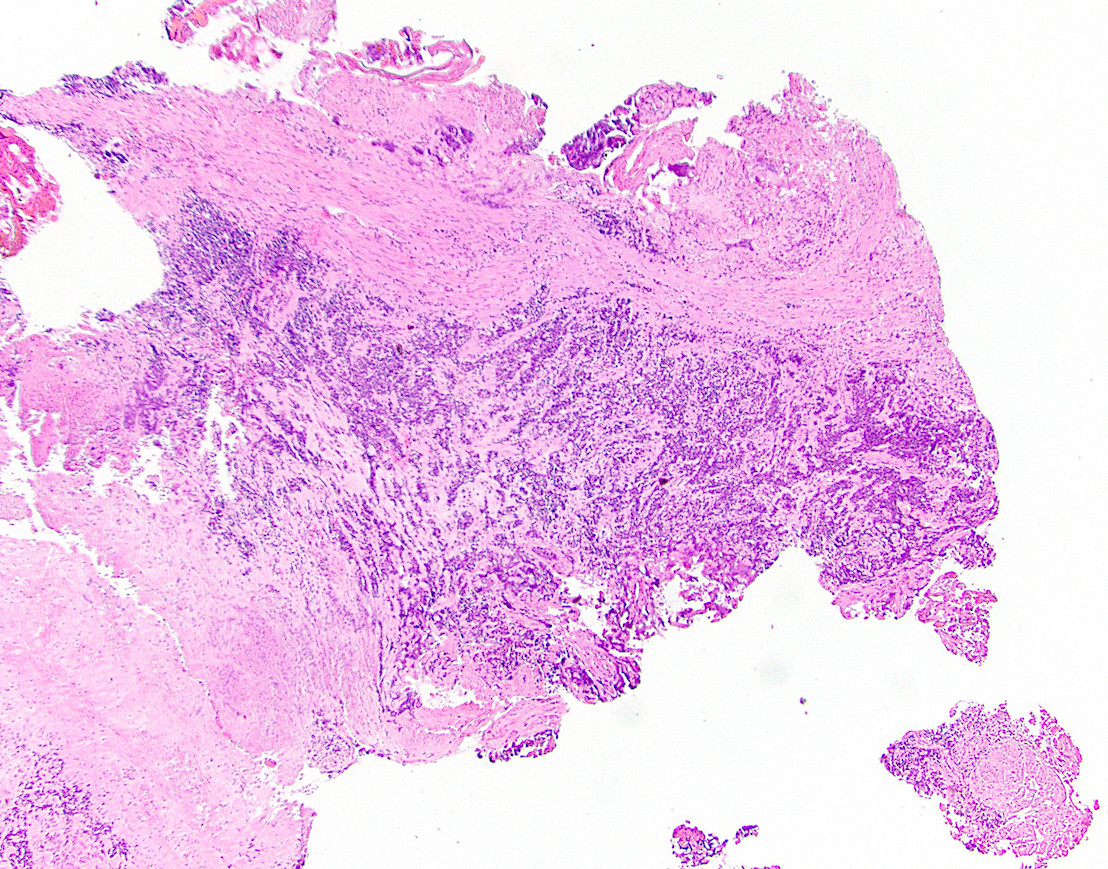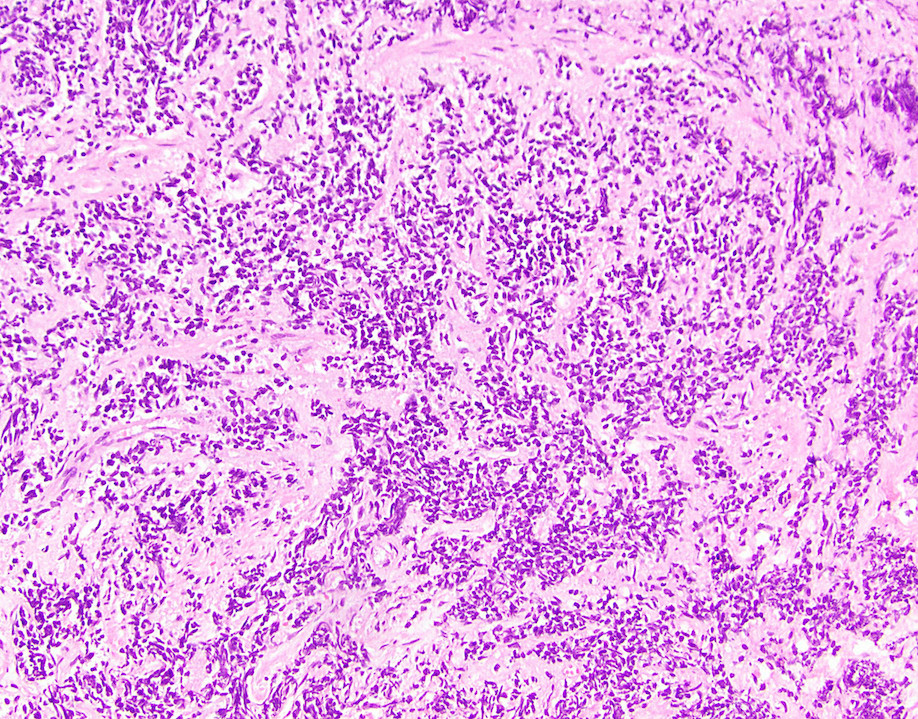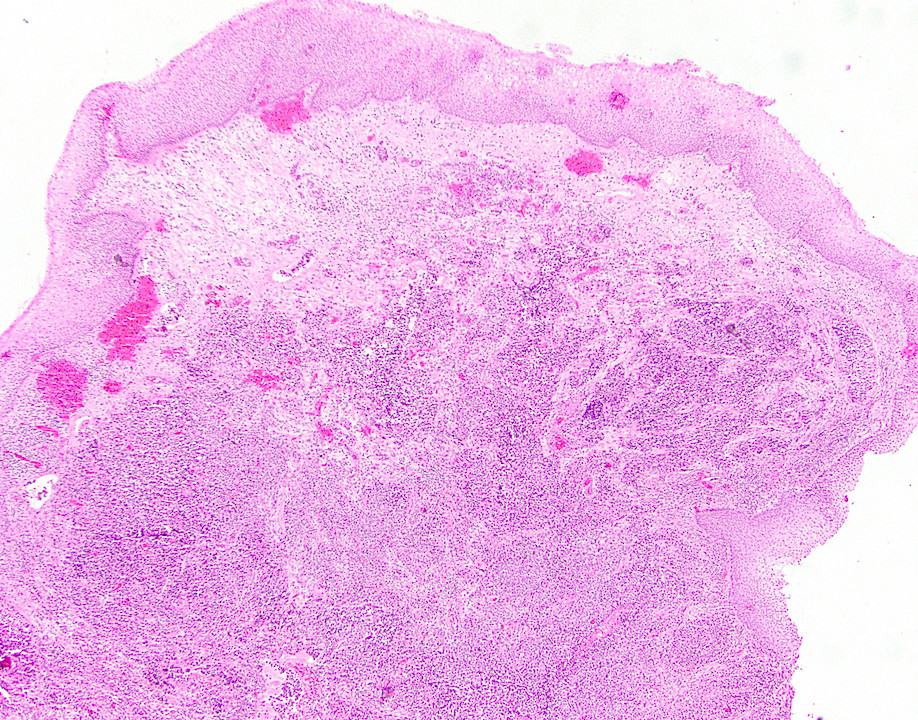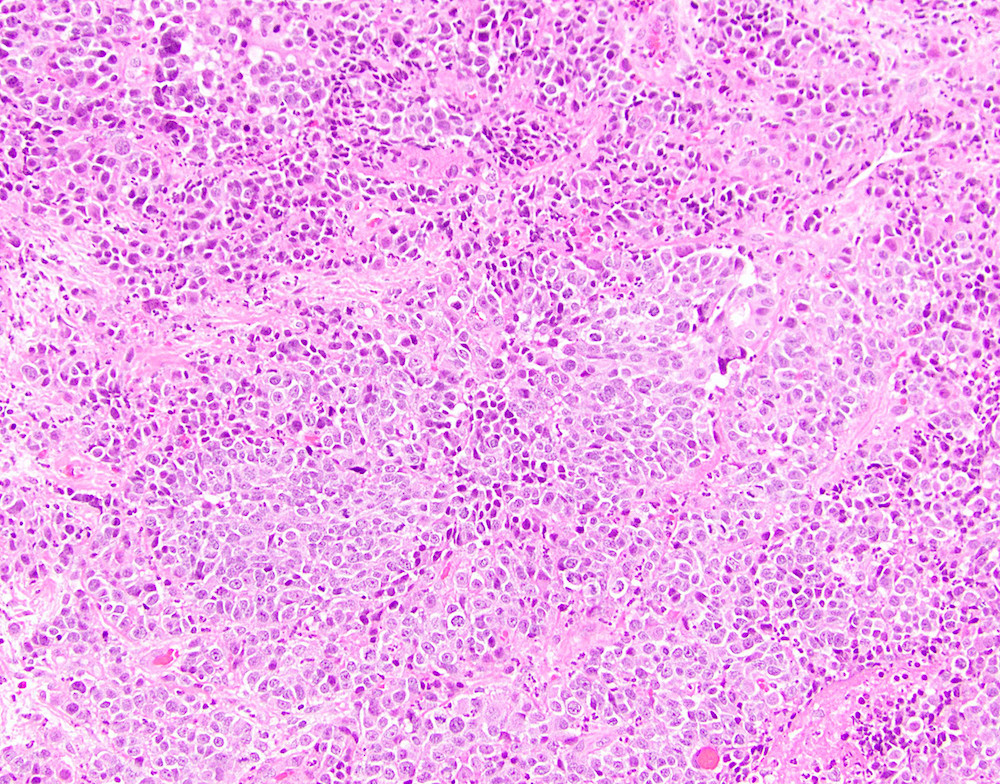Table of Contents
Definition / general | Essential features | ICD coding | Epidemiology | Pathophysiology | Clinical features | Diagnosis | Radiology description | Radiology images | Prognostic factors | Case reports | Treatment | Microscopic (histologic) description | Microscopic (histologic) images | Positive stains | Negative stains | Molecular / cytogenetics description | Sample pathology report | Differential diagnosis | Practice question #1 | Practice answer #1 | Practice question #2 | Practice answer #2Cite this page: Gonzalez RS. Neuroendocrine carcinoma. PathologyOutlines.com website. https://www.pathologyoutlines.com/topic/anussmallcell.html. Accessed August 29th, 2025.
Definition / general
- Poorly differentiated neuroendocrine carcinoma arising in the anus
Essential features
- Rare, primary neuroendocrine carcinoma of the anus
- Very aggressive, with early metastatic spread; 5 year survival is ~10%
- Similar histology to small cell or large cell neuroendocrine carcinoma at other sites
ICD coding
- ICD-10: C21.0 - malignant neoplasm of anus, unspecified
Epidemiology
- Represents ~7% of anal carcinomas (Cancer 1984;54:114)
Pathophysiology
- Associated with high risk HPV infection, though with low viral copy numbers (Am J Surg Pathol 2012;36:1087)
- Rb-E2F pathway dysregulation often occurs (Mod Pathol 2019;32:290)
Clinical features
- May cause rectal bleeding or present as an anal mass (Clin Colorectal Cancer 2021;20:e139)
Diagnosis
- Tissue sampling
Radiology description
- Destructive lesion; no features specific to neuroendocrine nature
Prognostic factors
- Higher stage confers poor prognosis
Case reports
- 37 year old man with painful anal fissure (BMC Gastroenterol 2020;20:290)
- 60 year old woman with small cell carcinoma of the anus (Cases J 2009;2:9396)
- 63 year old woman with extrapulmonary small cell carcinoma of the anal canal (Case Rep Med 2012;2012:341432)
Treatment
- Chemotherapy (often platinum based) and radiation
Microscopic (histologic) description
- Small cell neuroendocrine carcinoma: poorly differentiated malignancy composed of solid nests of small cells with minimal cytoplasm, hyperchromatic nuclei with molding, central necrosis and high mitotic activity; resembles pulmonary counterpart
- Large cell neuroendocrine carcinoma: poorly differentiated malignancy composed of solid nests of large cells with abundant cytoplasm, vesicular nuclei with prominent nucleoli, central necrosis and high mitotic activity
- May have overlying squamous cell carcinoma in situ or a squamous cell carcinoma component (namely, mixed neuroendocrine - nonneuroendocrine neoplasm) (Pathol Int 2012;62:356)
- No longer graded using WHO criteria, as it is essentially always high grade (mitotic rate > 20/2 square mm; Ki67 index > 20%)
Microscopic (histologic) images
Positive stains
- Pankeratin, neuroendocrine markers (synaptophysin, chromogranin, CD56, INSM1), p16, p63, HPV ISH
- Ki67 index is high (almost always > 20% and usually > 55%)
Negative stains
Molecular / cytogenetics description
- Molecular abnormalities often seen in TP53, Rb-E2F pathway (Mod Pathol 2019;32:290)
Sample pathology report
- Anus, mass, biopsy:
- Small cell neuroendocrine carcinoma (see comment)
- Comment: The carcinoma is positive for synaptophysin and chromogranin by immunohistochemistry. Neuroendocrine carcinomas are high grade by definition.
Differential diagnosis
- Basaloid squamous cell carcinoma:
- Negative for neuroendocrine markers
- Colorectal small cell carcinoma:
- May extend into anus
- Usually CDX2 positive
- Basal cell carcinoma:
- No necrosis, lower mitotic activity
- Arises in perianal skin rather than anus
- Well differentiated neuroendocrine tumor:
- Rare in anus
- Has carcinoid-like appearance, with no necrosis and few mitotic figures
- Poorly differentiated carcinoma, NOS:
- May resemble neuroendocrine carcinoma histologically but is negative for neuroendocrine markers
- Also no compelling evidence of glandular or squamous differentiation
Practice question #1
Practice answer #1
D. Synaptophysin. Anal small cell carcinoma, like all neuroendocrine carcinomas, is positive for synaptophysin. CD45 is positive in hematolymphoid neoplasms, CDX2 is positive in glandular rectal lesions and napsin A is positive in lung adenocarcinoma.
Comment Here
Reference: Anus & perianal area - Neuroendocrine carcinoma
Comment Here
Reference: Anus & perianal area - Neuroendocrine carcinoma
Practice question #2
Which of the following is true about neuroendocrine carcinoma of the anus?
- It has a good prognosis
- It is associated with HPV infection
- It is the most common anal malignancy
- It shows morphologic features unique to this site
Practice answer #2
B. It is associated with HPV infection. High risk HPV is usually detectable in anal neuroendocrine carcinoma, though at low copy numbers. This malignancy is rare and aggressive. Morphologically, it is indistinguishable from neuroendocrine carcinoma arising at other sites.
Comment Here
Reference: Anus & perianal area - Neuroendocrine carcinoma
Comment Here
Reference: Anus & perianal area - Neuroendocrine carcinoma









